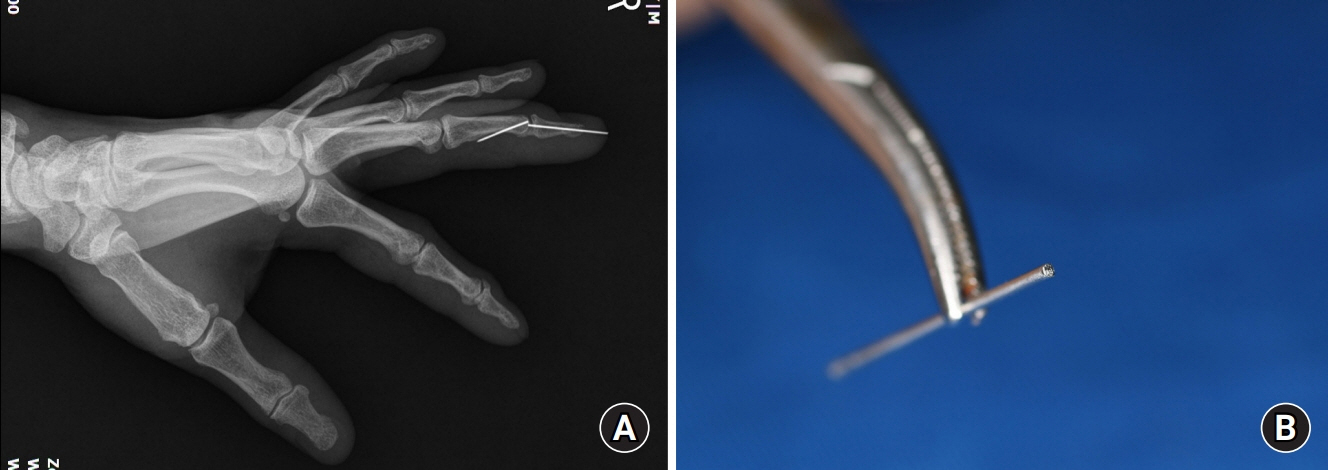Arch Hand Microsurg.
2021 Sep;26(3):171-173. 10.12790/ahm.21.0114.
Broken Kirschner Wire in Distal Interphalangeal Joint Fixation: A Case Report
- Affiliations
-
- 1Department of Plastic and Reconstructive Surgery, Gwangmyeong Sungae General Hospital, Gwangmyeong, Korea
- KMID: 2519470
- DOI: http://doi.org/10.12790/ahm.21.0114
Abstract
- Kirschner wire (K-wire) has been widely used for treatment of fracture for its cost-effectiveness and reliability. This case presents the K-wire breakage in distal interphalangeal joint (DIPJ) fixation. A 55-year-old male patient was injured by a knife and showed rupture of extensor tendon at 1/2 of middle phalanx. A 0.9-mm K-wire was implemented for DIPJ extension, and tenorrhaphy was done. After 6 weeks, we detected breakage of K-wire in the follow-up X-ray. The broken K-wire in the distal phalanx was removed. We removed the remaining K-wire through an incision on volar side of middle phalanx under C-arm after 2 weeks for the patient’s personal reasons. Breakage during postoperative K-wire maintenance is exceedingly rare. This patient is presumed to have ruptured because he continued using his finger. Therefore, while K-wire is present, continued use of finger without protection may cause breakage, so protective measures such as splint are required.
Keyword
Figure
Reference
-
1. Black D, Mann RJ, Constine R, Daniels AU. Comparison of internal fixation techniques in metacarpal fractures. J Hand Surg Am. 1985; 10:466–72.
Article2. Botte MJ, Davis JL, Rose BA, et al. Complications of smooth pin fixation of fractures and dislocations in the hand and wrist. Clin Orthop Relat Res. 1992; (276):194–201.
Article3. Hong SJ, Lee HJ, Kim JY, Eo SR, Cho SH. K-wire breakage during metalware removal due to a defective k-wire shaft. Arch Plast Surg. 2013; 40:655–7.
Article4. Pichler W, Mazzurana P, Clement H, Grechenig S, Mauschitz R, Grechenig W. Frequency of instrument breakage during orthopaedic procedures and its effects on patients. J Bone Joint Surg Am. 2008; 90:2652–4.
Article5. Stahl S, Schwartz O. Complications of K-wire fixation of fractures and dislocations in the hand and wrist. Arch Orthop Trauma Surg. 2001; 121:527–30.
Article6. Zingas C, Katcherian DA, Wu KK. Kirschner wire breakage after surgery of the lesser toes. Foot Ankle Int. 1995; 16:504–9.
Article7. Wong KY, Mole R, Gillespie P. Kirschner wire breakage during removal requiring retrieval. Case Rep Surg. 2016; 2016:7515760.
Article
- Full Text Links
- Actions
-
Cited
- CITED
-
- Close
- Share
- Similar articles
-
- Aorto-Innominate Venous Fistula after percutaneous kirschner wire fixation of the Sternoclavivular Joint Anterior Dislocation: A case report
- Removal of a Broken Intramedullary Nail with a Narrow Hollow Using a Bulb-tipped Guide Wire and Kirschner Wire: A Case Report
- Comparison between Two Kirschner Wire Fixation and Three Wire Fixation, in Treating of Metacarpal Neck Fracture Using Multiple Retrograde Kirschner Wire Fixation
- A Comparative Study of Range of Motion With or Without Distal Interphalangeal Joint Fixation in Replantation of the Amputated Fingertips
- Treatment of the Clavicle Lateral End Fracture by Kirschner wire and Wire fixation




